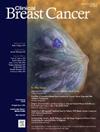阿霉素和环磷酰胺后剂量密集(每2周)紫杉醇联合曲妥珠单抗作为her2阳性早期乳腺癌新辅助治疗的安全性和有效性
IF 2.5
3区 医学
Q2 ONCOLOGY
引用次数: 0
摘要
背景:传统上,在早期HER2+乳腺癌的新辅助蒽环类化疗中,紫杉醇每周给药12次,每3周联合曲妥珠单抗(ACTH-W)。在加拿大安大略省,另一种方案包括每2周给药紫杉醇,同时每2周给药曲妥珠单抗,共4剂(ACTH-O)。方法:我们对2014年至2023年间接受序贯治疗的患者进行了回顾性、单机构图表回顾,以评估ACTH-O与FEC-DH、TCH和ACTH-W的疗效、安全性和资源利用率。结果:本分析共纳入300例患者。ACTH-O(37.1%)、FEC-DH(33.6%)和TCH(48.0%)的pCR率差异无统计学意义。虽然ACTH-W获得pCR的几率高于ACTH-O,但3年无病生存率在任何方案之间没有差异(ACTH-O为93.4%,ACTH-W为90%,93.3 FEC-DH为87.9%)。ACTH-O停药的频率较低,在所有方案中都有类似的罕见心脏毒性事件。ACTH-O的最低计划医疗保健亲自访问次数是ACTH-W的一半。治疗管理的估计费用减少了大约三分之一,这是资源有限的医疗保健系统的一个重要考虑因素。结论:在HER2+早期乳腺癌中,ACTH-O方案是标准蒽环类药物方案的可行替代方案。它提供了类似的长期效果,同时减少了时间毒性和医疗成本。鉴于这些优势,ACTH-O值得考虑更广泛的临床应用。本文章由计算机程序翻译,如有差异,请以英文原文为准。
Safety and Effectiveness of Adriamycin and Cyclophosphamide Followed by Dose Dense (Every 2 Weeks) Paclitaxel Given With Trastuzumab as Neoadjuvant Treatment in HER2-Positive Early-Stage Breast Cancer
Background
Traditionally, in neoadjuvant anthracycline-based chemotherapy for early-stage HER2+ breast cancer, paclitaxel is administered weekly for 12 doses combined with trastuzumab every 3 weeks (ACTH-W). In Ontario Canada, an alternative protocol consists of administering paclitaxel every 2 weeks concurrently with trastuzumab every 2 weeks for 4 doses (ACTH-O).
Methods
We conducted a retrospective, single-institution chart review of sequential patients treated between 2014 and 2023 to evaluate the efficacy, safety, and resource utilization of ACTH-O compared with FEC-DH, TCH, and ACTH-W.
Results
A total of 300 patients were included in this analysis. There was no statistically significant difference in pCR rates between ACTH-O (37.1%), FEC-DH (33.6%), and TCH (48.0%). Although the odds of achieving pCR was higher with ACTH-W than ACTH-O, disease-free survival at 3 years did not differ between any of the regimens (93.4% for ACTH-O, 90% for ACTH-W, 87.9% for 93.3 FEC-DH). Discontinuation was less frequent with ACTH-O, with similar rare cardiotoxicity events across all regimens. The minimum number of planned healthcare in-person visits for ACTH-O was half that of ACTH-W. The estimated cost of treatment administration was reduced by approximately one third, an important consideration in a resource-constrained healthcare system.
Conclusion
ACTH-O regimen is a viable alternative to standard anthracycline-based regimens in HER2+ early breast cancer. It offers similar long-term outcomes while reducing time toxicity and healthcare costs. Given these advantages, ACTH-O warrants consideration for broader clinical adoption.
求助全文
通过发布文献求助,成功后即可免费获取论文全文。
去求助
来源期刊

Clinical breast cancer
医学-肿瘤学
CiteScore
5.40
自引率
3.20%
发文量
174
审稿时长
48 days
期刊介绍:
Clinical Breast Cancer is a peer-reviewed bimonthly journal that publishes original articles describing various aspects of clinical and translational research of breast cancer. Clinical Breast Cancer is devoted to articles on detection, diagnosis, prevention, and treatment of breast cancer. The main emphasis is on recent scientific developments in all areas related to breast cancer. Specific areas of interest include clinical research reports from various therapeutic modalities, cancer genetics, drug sensitivity and resistance, novel imaging, tumor genomics, biomarkers, and chemoprevention strategies.
 求助内容:
求助内容: 应助结果提醒方式:
应助结果提醒方式:


